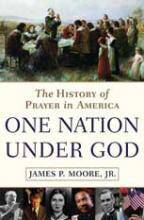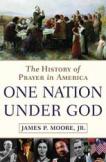It's in Our Blood
Andrew Greeley has described Catholicism using James Joyce’s phrase Here comes everyone. Those exuberant words can also be applied to James P. Moore’s history of prayer in America. Moore is the founder and C.E.O. of the investment banking firm ATI (formerly AmeriTrade International) and has held a number of senior government positions, including that of assistant secretary of commerce during the Reagan administration.
A trained political scientist and professor of international business and corporate ethics at Georgetown University, he might seem an unlikely person to research and write about this neglected aspect of American history. Without theological training, but with a lifelong interest for everything American, Moore emerged from more than six years in libraries and archives with a book that is profoundly respectful of both the ineffability of prayer and the uniqueness of the American experience.
One Nation Under God offers a vivid portrait of the pervasive influence private and public prayer has had on American social, cultural and political history. Traditional ways of framing the American religious storytheological debates, religious conflicts and the growth of congregations and religious institutionsare less important to Moore than the evidence of the fruits of prayer. He respects the personal religious convictions revealed in the public utterances of presidents and generals, clerics and Congressmen, but he also hears the faith, humility and praise in the voice of anonymous parents, farmers and soldiers. Moore writes about religious leaders and popular singers, novelists and architects, and his subjects include Tommy Dorsey and John McCain, Billy Sunday’s sermons and McGuffey’s readers, Dorothy Day and Starbucks’ C.E.O. Howard Schultz, Jonathan Edwards and Elvis Presley. He turns the broadest possible lens on the rich mosaic of the American experience without creating a forced exercise in diversity.
The beautiful hymns and prayers in this book make it a suitable source of personal devotional material, as do the thoughtful narratives drawn from Moore’s extensive reading. One anecdote tells of 27-year-old Phil Donahue, then working for a local CBS affiliate in Ohio, who was covering a mining accident in West Virginia when a preacher in his thirties called some of the rescuers together to pray.... They filmed the scene as the minister sang and prayed, but just as they began to savor their exclusive for the evening news they realized that because of the extreme cold, the camera had recorded nothing. Donahue lost no time in approaching the preacher, explaining who he was, what had happened, and how he needed to have him repeat the informal prayer service for the camera. To his amazement, the preacher calmly looked at him and said, But I have already prayed, son.’ Reverend,’ Donahue clearly enunciated, I am from CEE BEE ESS NEWS.’ Wouldn’t be honest,’ the minister responded as he walked away.
Moore finds ample evidence of that kind of moral clarity in Americans at prayer, especially amid the courage, anguish and honesty of our soldiers and military chaplains. He gives less attention to religious pacifism, which may reflect not an ideological slant, but the sad and simple recognition of the extent to which American history is inseparable from its wars. He does include a fine description of Mark Twain’s biting and powerful War Prayer, an emotional commentary from beyond the grave with its stark conclusion that the American people did not fully comprehend the actions of their leaders. Moore’s discussion of prayer during the Civil War, when God was effectively being set up in an absurd way, pitted between two diametrically opposed forces and positions is a case study in public theology and, given our distance from those events, can offer a paradigm for understanding contemporary religious claims.
This is a particularly timely book, because it clearly illustrates the American tendency to resort to religious revivals during periods of social and intellectual crisis. In the period between the Civil War and World War I, for example, people struggled to make sense of the war, the suffering and social dislocations of the Industrial Revolution, and the implications of Darwin’s theory of evolution: ...by 1880 a new great awakening, the third in American history, had begun to blossom. What evolved during this period, and lasted well into the next century, was a combination of spiritual romanticism and the conviction that in the midst of rapid social and economic change the Golden Rule applied...more than ever.
It should come as no surprise, therefore, that we have responded to post-Sept. 11 terrorism with an increased focus on personal and social sin. Nor should it be a surprise that the current debate echoes with the language of Protestant theology, with its notes of revivalism, moral perfectionism, religious individualism and sectarian purity. For all the rich religious and social contributions that Catholics and Jews have made to U.S. society, Moore’s book is a vivid reminder that this nation was, and remains, a country utterly dominated by the Protestant religious narrative.
There are some factual errors (he says, for example, that Thomas Merton marched with Martin Luther King Jr., when in fact Merton was in Gethsemane), and some will disagree with his analysis of particular events and personalities. But no one can quarrel with Moore’s admirable and refreshing lack of cynicism. Surely the God addressed in these prayers heard and received them with no less wholehearted an embrace of human need and aspiration, such evident respect and kindness.
This article also appeared in print, under the headline “It's in Our Blood,” in the March 6, 2006, issue.









